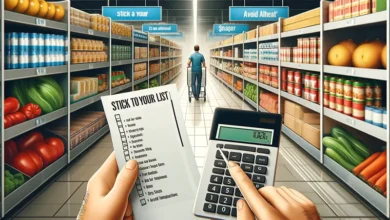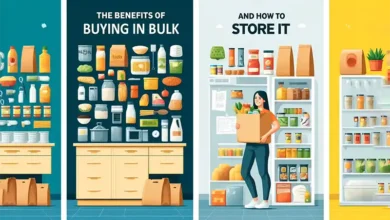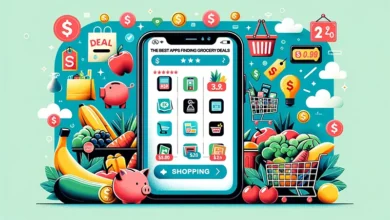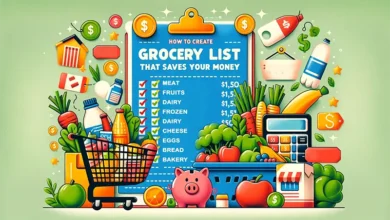Meal Planning Tips to Cut Down on Grocery Costs

Introduction
With grocery prices literally going through the roof, families are finding it harder and harder to keep their food budgets under control. For a family, during the last year, food cost for at-home consumption has increased 10.9%—that is really squeezing family budgets. Meal planning has become such a superpower; it is sure to boost your savings on the grocery bill without leaning much on the scale of a poor diet and tasteless meals. With this in place, you can greatly reduce how much you spend on food, reduce waste, and stay within your macronutrient objectives. In this module, we will discuss the basics of meal planning, effective strategies that will help you maximize savings, smart tips for grocery shopping, techniques for reducing food wastage, and important resources which shall help make meal planning an easy affair.
Understanding the Basics of Meal Planning
Definition and Benefits
- Meal preparation is actually choosing what they would prepare in the future and making a shopping list, then sticking to the budget.
- Some advantages to meal planning include saving you money on groceries, saving on foods that would have gone to waste, and eating better, which ultimately reduces stress at mealtimes.
Getting Started
- Take an inventory of the contents of your pantry, refrigerator, and freezer, figuring what you already have on hand.
- Establish a realistic grocery budget based on how many people are in the household, dietary preferences, and income. Establish the need and preference for the dietary requirements of your household, putting into consideration allergies, food intolerance, and special diets.
Meal Planning Strategies
Develop a Weekly Meal Plan
- Design an eat well balanced weekly menu that includes all proteins, cereal, grain, fruit, and vegetables.
- Factor in leftovers while planning, so as to waste less and save on time.
- Example: Grilled chicken with roasted vegetables on Monday, Leftover chicken salad sandwiches on Tuesday, Vegetarian chili on Wednesday, and so on.
Work Around Discounts And Sales
- Every week, check grocery stores’ flyers in your area for sales and discounts.
- Fit in with the local small farmers market.
- Utilize apps such as Flipp and Favado to help find some of the best deals available to you in your local area.
Batch Cooking and Freezing
- Other benefits of batch cooking are time-saving, less wastage of food, plus ready-to-eat meals.
- Batch Cooking: Step-By-Step Instructions—plan your recipes, prep your ingredients, cook in large big batch, and portion and store.
- Cooking and freezing in batches work best with soups, stews, casseroles, and bakery items.
Use Low-Budget Staples
- For preparation of healthy and filling food – rice, beans, lentils, pasta, oats are considered as pocket-friendly staples.
- Examples of this would include, for instance, rice and bean burritos or lentil bolognese on whole-wheat spaghetti.
Add Meatless Meals
- Finally, not as much meat will save you so much money on your bill for groceries.
- Vegetable stir-fries, lentil and vegetable curries, pasta dishes chock-full of vegetables, and chili with beans.
Smart Grocery Shopping Tips
Make a Shopping List
- Make a detailed list for shopping depending on your meal plan so that it does not lead to impulse buying.
- Stick to your list: Don’t shop at hungry times, don’t move too much inside the store, and avoid temptation at end-cap displays.
- Shop Smart
Deals can be found in the mornings and late evenings
- Stick to your list and walk around those tempting displays that tend to encourage impulse buys.
- Shop at Aldi or Lidl; these are grocery discount stores. Visit farmer markets; you can buy fresh and locally-sourced vegetables and fruits there.
Shop for Bulk Non-perishables
- Shopping in bulk helps in saving money as well as time. One may get good discounts on purchasing their required grains, nuts, and spices in bulk amounts when kept properly, they can help in saving money.
- Proper storage in airtight containers and at cold, dry places may prevent spoilage.
Use Store Brands
- Many times, store brands are of the same high quality as name brands but are generally much cheaper.
- Compare ingredient and nutrition labels to ensure that you’re getting a similar product at a lower cost.
Food Waste Management
Appropriate Storage Techniques
- Learn how to correctly store different food items to enable them to last as long as possible.
- Tips on organizing your pantry as well as your refrigerator to be able to see what you have and use items up before they go bad.
Repurpose Leftovers
- Reshape old meals into new ones in order to reduce waste and stay inspired by your food.
- Use leftover vegetables, meats, and grains in recipes like frittatas, stir-fries, and soups.
Composting
- Composting is a green, sound means of disposal of food scraps to reduce waste.
- Benefits of composting are a reduction in the emission of methane gas from landfills and the creation of nutrient-rich soil for your garden.
Tools and Resources for Meal Planning
Apps and Websites
- Meal planning apps such as Mealime, Plan to Eat, and Prepear make creation of shopping lists and recipe finding easy.
- Websites such as Budget Bytes and Skinnytaste are excellent sources of budget-friendly and healthy recipes.
Cookbooks, Blogs
- Cookbooks focused on cheaper meal solutions like “Good and Cheap” by Leanne Brown and “The $5 Meal Plan” by Erin Chase are ideal resources for dirt-cheap recipes and meal planning methods.
- $5 Dinners and Budget Bytes Blogs can provide a vast amount of budget-friendly recipes and meal planning advice.
Meal Planning Services
Finally, there are subscription-based meal planning services, such as eMeals and PlateJoy, that will allow you to plug in your preferences and your budget. It will then spit out a week-by-week plan along with a grocery list that you can print out or view on your smartphone.
Conclusion
- Meal planning is effective for saving money on groceries, reducing food waste in the household, and improving the dietary practices of the household.
- By learning how to plan your week’s menu, plan around the sales, batch cook, prioritize affordable staples, and include a meatless meal here and there, for example, you can significantly shave hundreds of dollars off your grocery budget.
- Smart grocery shopping strategies that include simple methods like always making a list, shopping discount stores, buying in bulk, and buying store brand, can stretch your food budget even farther.
- You can reduce food waste, and its cost, through proper food storage, creative use of leftovers, and composting.
- Many apps, websites, cookbooks, and meal planning services are available to make the process easier and more efficient.
Meal planning seems overwhelming. Just remember, start small and work your way up. Small savings can add up over time into big savings.
Share your tweets, comments below, or better yet your recipes, meal planning successes and snafus with #MealPlanningOnABudget to join the collective #MealPlanningOnABudget movement where we all support each other in making our grocery budget decisions the best they can be.
FAQs
How could I set a realistic grocery budget?
One of the first steps in setting an appropriate budget is monitoring what you currently spend on groceries in a month to have a baseline level of spending. To set a realistic budget, consider size of household, dietary needs, and the total amount of income. Try to reduce it a little at a time—you can try different amounts weekly until you hit the sweet spot.
How can meal planning save you money?
Meal planning helps prevent impulse purchases, maximizes the use of items on sale and discounts, is time and work efficient, and can help prevent wasting money on uneaten food. Besides being good for the wallet, meal planning helps prevent food waste and maximizes the use of inexpensive staple ingredients. If you plan your meals in advance and shop with a list in hand, it is not likely you will overspend.
How do I plan a weekly menu?
Plan balanced menus that include a variety of proteins, grains, fruits, and vegetables. Consider leftovers—it will save time and be less wasteful. Check to see what you have on hand in your pantry and freezer. Make your meal plan around items you have and what ingredients are on sale.
How do I save money with batch cooking and freezing meals?
Batch cooking means that you cook a larger quantity of meals and portion out for future use. This will save time and reduce waste. Great ideas include soups, stews, casseroles, and baked goods.
What are some cheap staple ingredients on which to stock up?
Some economical staples include rice, beans, lentils, pasta, oats, and low-cost fruits and veggies. Here are some examples:
- Potatoes
- Carrots
- Onions
You can make a ton of different hearty and healthy meals out of these simple ingredients.




